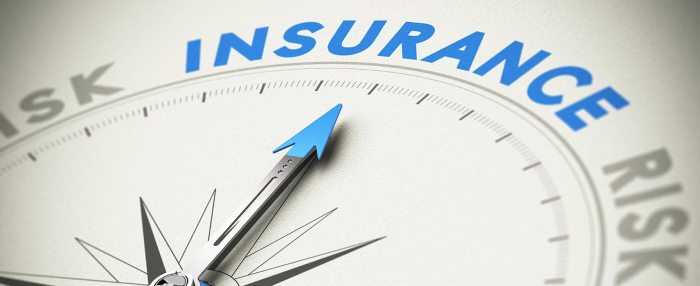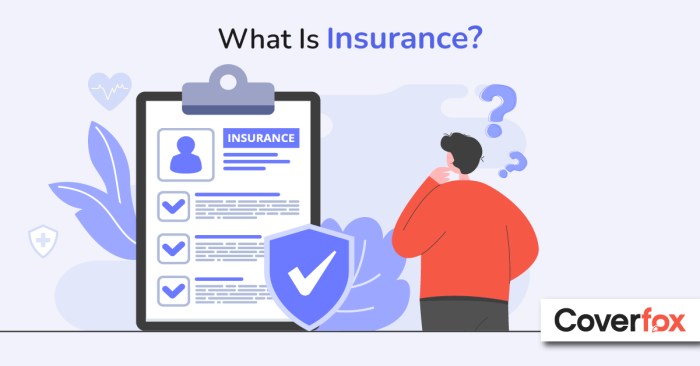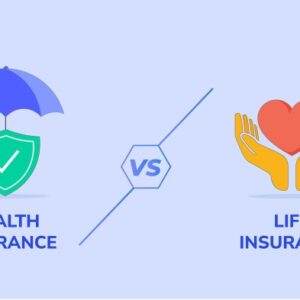Insurance. It’s the often-overlooked safety net that cushions the blow when life throws a curveball. From protecting your home and car to securing your family’s future, understanding insurance is crucial for navigating the complexities of modern living. This deep dive explores the multifaceted world of insurance, from the various types of coverage available to the intricacies of filing a claim and the future of the industry itself. We’ll unravel the jargon, clarify the complexities, and empower you to make informed decisions about your financial well-being.
We’ll cover everything from the basics of term life versus whole life insurance to the impact of technology and climate change on the industry. Learn how to compare quotes, understand policy terms, and navigate the claims process with confidence. Whether you’re a seasoned homeowner or just starting out, this guide will provide you with the knowledge you need to secure your future.
Types of Insurance
Navigating the world of insurance can feel like deciphering a complex code, but understanding the basics is key to protecting yourself and your future. Insurance, at its core, is a risk management tool; you pay a premium to transfer the risk of potential financial loss to an insurance company. Let’s break down the common types and their nuances.
Categories of Insurance
Insurance policies are broadly categorized by the type of risk they cover. These categories often overlap, and some policies combine elements from multiple categories. Understanding these categories helps you identify the right coverage for your specific needs.
- Property Insurance: This protects your physical assets from damage or loss. Homeowners insurance, renters insurance, and auto insurance fall under this umbrella. It covers things like fire damage, theft, and liability for accidents on your property.
- Liability Insurance: This covers you against financial responsibility for causing harm to others or their property. Auto insurance (for accidents you cause), professional liability insurance (for mistakes in your work), and umbrella insurance (for broader liability protection) are examples.
- Health Insurance: This covers medical expenses, including doctor visits, hospital stays, and prescription drugs. There are various types, from HMOs and PPOs to catastrophic plans, each with different coverage levels and cost-sharing mechanisms.
- Life Insurance: This provides a financial payout to your beneficiaries upon your death. It helps ensure your loved ones’ financial security after you’re gone. There are several types, including term and whole life insurance, which differ significantly in their features and costs.
Term Life Insurance vs. Whole Life Insurance
Choosing between term and whole life insurance depends on your financial goals and risk tolerance. Term life insurance provides coverage for a specific period (term), like 10 or 20 years. If you die within the term, your beneficiaries receive the death benefit. Whole life insurance, on the other hand, provides lifelong coverage, building a cash value component that grows over time.
Term life insurance is generally more affordable, making it a suitable option for those who need temporary coverage, such as during their working years when they have dependents. Whole life insurance, while more expensive, offers permanent coverage and a cash value component that can be borrowed against or withdrawn. It’s often seen as a long-term investment and estate planning tool.
Comparison of Health Insurance Plans
The cost and coverage of health insurance plans vary significantly. Here’s a simplified comparison of three common types:
| Plan Type | Coverage | Cost |
|---|---|---|
| HMO (Health Maintenance Organization) | Generally lower premiums, but requires using in-network providers. May offer preventative care at no cost. | Lower premiums, but potentially higher out-of-pocket costs if you need care outside the network. |
| PPO (Preferred Provider Organization) | More flexibility to choose in-network and out-of-network providers, but higher premiums. | Higher premiums, but potentially lower out-of-pocket costs if you choose in-network providers. More flexibility in choosing providers. |
| High-Deductible Health Plan (HDHP) with HSA (Health Savings Account) | Lower premiums, but higher deductible. An HSA allows you to save pre-tax money for medical expenses. | Lower premiums, but significant out-of-pocket expenses until the deductible is met. However, the HSA offers tax advantages. |
Insurance Purchasing Process
Navigating the world of insurance can feel like deciphering a secret code, but it doesn’t have to be a headache. Understanding the process, from comparing quotes to filing a claim, empowers you to make informed decisions and protect what matters most. This section breaks down the key steps, making insurance less intimidating and more manageable.
Purchasing insurance, whether it’s for your car or your home, involves a series of steps. Let’s walk through the process, offering practical advice along the way.
Purchasing Car Insurance
The process of buying car insurance typically begins with obtaining quotes from multiple providers. You’ll need to provide information about your vehicle, driving history, and desired coverage. Once you’ve compared quotes, you can choose a policy that best suits your needs and budget. After selecting a policy, you’ll complete an application, often online, providing further details. The insurance company will then review your application and, if approved, issue a policy. You’ll receive your insurance card and policy documents, confirming your coverage. Remember to keep your policy information readily accessible.
Filing a Home Insurance Claim
Experiencing home damage is stressful enough, but navigating the insurance claim process shouldn’t add to the burden. First, contact your insurance provider immediately after the incident. Report the damage thoroughly, providing as much detail as possible. Your insurer will likely send an adjuster to assess the damage and determine the extent of the coverage. Cooperate fully with the adjuster, providing any necessary documentation or information. The adjuster will then prepare an estimate of the repair costs. Once the estimate is approved, you’ll receive payment from your insurance company, which you can then use to cover the repairs or replacement costs. Keep detailed records of all communication and documentation throughout the process.
Comparing Insurance Quotes
Before committing to a policy, comparing quotes from different providers is crucial. This allows you to find the best coverage at the most competitive price.
Here are some key factors to consider when comparing quotes:
- Coverage Levels: Compare the levels of coverage offered by each provider. Consider liability limits, comprehensive and collision coverage, and any additional options.
- Premiums: The premium is the amount you pay for your insurance. Compare premiums from different providers to find the most affordable option that meets your needs.
- Deductibles: Your deductible is the amount you pay out-of-pocket before your insurance coverage kicks in. A higher deductible typically results in a lower premium, and vice versa. Consider your risk tolerance and financial situation when choosing a deductible.
- Discounts: Many insurers offer discounts for various factors, such as safe driving records, bundling policies, or installing security systems. Inquire about available discounts to potentially lower your premium.
- Customer Service: Read reviews and check ratings to get an idea of the insurer’s customer service reputation. A responsive and helpful insurer can make a big difference if you need to file a claim.
- Financial Stability: Check the insurer’s financial strength rating to ensure they are financially stable and able to pay claims. Independent rating agencies provide these ratings.
Insurance Regulations and Laws

Source: googleapis.com
Navigating the world of insurance can feel like wading through a swamp of jargon and fine print. But behind the complex policies and premiums lies a crucial framework: government regulation. These regulations are designed to protect both consumers and the stability of the insurance industry itself, ensuring fair practices and preventing market failures. Understanding these rules is key to making informed decisions and avoiding potential pitfalls.
The insurance industry isn’t a free-for-all; it operates under a strict regulatory environment. Government agencies at both the federal and state levels play a significant role in overseeing insurers, ensuring they meet specific standards of solvency, conduct, and consumer protection. This involves setting minimum capital requirements, reviewing policy language, and investigating complaints. The goal is to maintain a healthy and trustworthy insurance market that serves the public interest.
Government Agencies’ Role in Insurance Regulation
Various government agencies are responsible for regulating the insurance industry, depending on the type of insurance and the geographical location. At the federal level, agencies like the Federal Insurance Office (FIO) in the U.S. monitor the overall health of the insurance market and identify systemic risks. State-level insurance departments, on the other hand, typically have direct oversight of individual insurance companies operating within their borders. They license insurers, review their financial statements, and investigate consumer complaints. This dual regulatory system ensures both national stability and localized responsiveness to specific market conditions. For example, a state insurance department might investigate a complaint about unfair claims practices by an auto insurer operating within that state, while the FIO might monitor trends in cybersecurity risks across the entire national insurance sector.
Key Legal Aspects of Insurance Contracts
Insurance policies are legally binding contracts. Understanding the key terms and conditions is vital. These contracts Artikel the insurer’s obligations (paying claims that meet the policy’s terms) and the policyholder’s obligations (paying premiums and providing accurate information). Key elements include the definition of covered perils (what events are insured against), exclusions (events not covered), the policy limits (the maximum amount the insurer will pay), and the policy period (the duration of coverage). A breach of contract by either party can have significant legal consequences. For instance, if an insurer fails to pay a legitimate claim, the policyholder can sue for breach of contract. Conversely, if a policyholder intentionally misrepresents information on their application (e.g., failing to disclose a pre-existing medical condition), the insurer may be able to void the policy.
Implications of Violating Insurance Regulations
Violating insurance regulations can lead to severe consequences for both insurance companies and policyholders. For insurance companies, penalties can include hefty fines, license revocation, and even criminal charges in cases of fraud or intentional misconduct. For policyholders, violating regulations (such as failing to disclose material information during the application process) can result in policy denial, claim rejection, or even criminal prosecution in cases of insurance fraud. The specific penalties vary widely depending on the nature and severity of the violation and the jurisdiction. For example, a small, unintentional error in a policy application might lead to a minor correction, while a large-scale fraud scheme could result in significant fines and imprisonment.
Insurance and Risk Management
Insurance is fundamentally about risk management. Insurance companies exist to assess, quantify, and ultimately manage the risk of unforeseen events. This involves a complex interplay of statistical analysis, actuarial science, and sophisticated modeling to determine the likelihood and potential cost of various claims. By pooling risks from numerous individuals or businesses, insurers can spread the financial burden of these events, making them manageable and predictable.
Insurance companies use a variety of methods to assess risk. This begins with the application process, where potential policyholders provide detailed information about themselves and the assets they wish to insure. This information is then analyzed, often using algorithms and predictive modeling, to assess the likelihood of a claim. Factors considered vary greatly depending on the type of insurance, but can include age, health, location, occupation, and the specifics of the item being insured. For example, a car insurance company will consider the driver’s history of accidents, the make and model of the car, and the location where the car is primarily driven. The higher the assessed risk, the higher the premium the insurer will charge.
Risk Assessment and Pricing
The core of an insurance company’s operation lies in accurately assessing and pricing risk. They employ actuaries – highly trained professionals – who use statistical models and historical data to predict the likelihood and severity of future claims. These models incorporate various factors to refine their predictions, enabling insurers to set premiums that adequately cover expected payouts while maintaining profitability. For instance, a homeowner’s insurance company might use historical data on fire incidents in a specific zip code to determine the likelihood of a fire-related claim and adjust premiums accordingly. This process is constantly refined, with new data and insights continually incorporated to improve accuracy and efficiency.
Scenario: Mitigating Financial Loss, Insurance
Imagine a small bakery, “Sweet Surrender,” relying heavily on its ovens for daily operation. A fire damages the ovens, halting production and causing significant financial losses. Without business interruption insurance, Sweet Surrender would face substantial costs for repairs, lost income, and potential closure. However, with adequate coverage, the insurance policy compensates the bakery for the repairs, lost revenue, and other related expenses, allowing it to recover and continue operations. This demonstrates how insurance transforms a potentially catastrophic event into a manageable setback.
Risk Management Strategies: Individuals vs. Businesses
Individuals and businesses employ different risk management strategies, though both share the core goal of minimizing potential losses. Individuals often rely on insurance as a primary risk management tool, alongside preventative measures like securing their homes or driving cautiously. Businesses, on the other hand, often adopt more comprehensive strategies, including risk assessment, diversification, mitigation (implementing safety protocols), and transfer (using insurance).
Businesses might implement a robust risk management plan encompassing: Identifying potential hazards (e.g., equipment malfunction, cyberattacks), assessing the likelihood and potential impact of each hazard, developing mitigation strategies (e.g., regular maintenance, cybersecurity training), and purchasing insurance to transfer some of the remaining risk. They may also employ sophisticated risk modeling and analysis to predict potential losses and proactively manage their exposure. This contrasts with individual risk management, which is often less formal and relies more heavily on individual judgment and readily available insurance products.
The Future of Insurance

Source: murrayins.com
The insurance industry, traditionally a bastion of paperwork and slow-moving processes, is undergoing a radical transformation. Driven by technological advancements and evolving societal needs, the future of insurance looks vastly different from its past. This shift is creating both exciting opportunities and significant challenges for insurers, agents, and consumers alike.
Technological Disruption in Insurance
The impact of technology on insurance is profound and multifaceted. Artificial intelligence (AI) is revolutionizing underwriting, claims processing, and customer service. AI-powered algorithms can analyze vast datasets to assess risk more accurately and efficiently, leading to faster claims processing and potentially lower premiums for low-risk individuals. Big data analytics allows insurers to identify emerging trends and patterns, enabling them to proactively manage risk and develop new products tailored to specific customer segments. For example, telematics data from connected cars is already being used to offer usage-based insurance, rewarding safe driving habits with lower premiums. This data-driven approach not only improves efficiency but also personalizes the customer experience.
Climate Change and Insurance
Climate change presents both a significant challenge and a substantial opportunity for the insurance industry. The increasing frequency and severity of extreme weather events, such as hurricanes, floods, and wildfires, are leading to a surge in insurance claims. This is driving up premiums, particularly in high-risk areas, and even prompting some insurers to withdraw coverage altogether. However, this also creates a significant opportunity for insurers to develop innovative products and services that help mitigate climate risk. This includes offering parametric insurance, which pays out automatically based on pre-defined weather events, and developing risk-assessment models that incorporate climate change projections. Insurers are also increasingly investing in sustainability initiatives and supporting climate-resilient infrastructure development. For instance, insurers are partnering with businesses to develop climate-resilient buildings and infrastructure, thereby reducing future losses.
Emerging Trends in Insurance
Several key trends are shaping the future of the insurance sector. One significant trend is the rise of Insurtech, a combination of insurance and technology, which is driving innovation across all aspects of the industry. New product offerings include micro-insurance, tailored to low-income populations, and on-demand insurance, providing coverage for specific events or periods. Distribution models are also changing, with digital platforms and online marketplaces becoming increasingly important channels for selling insurance. Another trend is the increasing use of blockchain technology to improve transparency and security in insurance transactions. For example, blockchain can streamline claims processing by providing an immutable record of events, reducing the potential for fraud and disputes. Finally, the increasing demand for personalized insurance products is driving the development of AI-powered tools that can tailor coverage to individual needs and risk profiles, further enhancing customer experience and satisfaction. Examples include personalized health insurance plans based on individual genetic predispositions or customized auto insurance plans based on driver behavior and vehicle characteristics.
Insurance and Specific Industries
Insurance isn’t a one-size-fits-all solution. The risks faced by a tech startup are vastly different from those of a construction firm, necessitating specialized insurance products tailored to each industry’s unique challenges. This section explores how insurance protects businesses across various sectors and the varying needs of companies of different sizes.
Specialized Insurance Products for Specific Industries
Different industries face unique hazards. Construction sites, for example, are inherently risky environments, prone to accidents, injuries, and property damage. Construction insurance often includes workers’ compensation, general liability, and builders’ risk insurance to cover these potential losses. Aviation, another high-risk sector, requires specialized aviation insurance to cover hull damage, liability for passenger injuries, and potential third-party damages. The tech industry, meanwhile, faces the ever-growing threat of cyberattacks and data breaches, leading to a surge in demand for cyber liability insurance. These specialized policies offer coverage specifically designed to mitigate the risks inherent in each industry.
Insurance Protection Against Business Risks
Insurance plays a crucial role in safeguarding businesses from various risks. Cyberattacks, for instance, can cripple a company’s operations, leading to significant financial losses and reputational damage. Cyber liability insurance helps cover the costs associated with data breaches, including legal fees, notification costs, and credit monitoring services for affected customers. Product liability insurance protects businesses against claims arising from injuries or damages caused by their products. If a faulty product causes harm, this insurance can cover legal costs, settlements, and judgments. Other crucial areas of protection include property insurance (covering physical damage to business assets), business interruption insurance (compensating for lost income during downtime), and professional liability insurance (protecting professionals from claims of negligence or malpractice).
Insurance Needs: Small Businesses vs. Large Corporations
The insurance needs of small businesses differ significantly from those of large corporations. While both require general liability and property insurance, the scale and complexity of their needs vary.
| Feature | Small Business | Large Corporation | Key Difference |
|---|---|---|---|
| Insurance Coverage | Often relies on basic packages; may self-insure for minor risks. | Requires comprehensive and customized policies across multiple locations and subsidiaries; often employs risk management teams. | Breadth and depth of coverage |
| Risk Management | Often lacks dedicated risk management personnel; relies on basic risk mitigation strategies. | Employs dedicated risk management professionals; proactive risk assessment and mitigation strategies are integral to operations. | Sophistication of risk management |
| Premium Costs | Generally lower premiums due to lower exposure and simpler operations. | Higher premiums due to increased exposure, complex operations, and higher potential losses. | Premium cost scale |
| Insurance Brokerage | May rely on independent brokers or direct insurers. | Often works with specialized insurance brokers handling complex risk profiles and large-scale coverage needs. | Brokerage specialization |
Insurance Claims Process
Navigating the insurance claims process can feel like traversing a maze, especially after a stressful event like a car accident or a health issue. Understanding the steps involved, however, can significantly ease the burden and improve your chances of a fair and timely settlement. This section breaks down the process, focusing on car accident and health insurance claims.
Car Accident Claim Investigation and Processing
After a car accident, the claims process begins with reporting the incident to your insurance company. This typically involves providing details of the accident, including date, time, location, and the individuals involved. Your insurer will then initiate an investigation to determine liability and the extent of damages.
The Roles of Adjusters and Investigators
Insurance adjusters are responsible for evaluating the claim and determining the amount of compensation to be paid. They review police reports, witness statements, medical records, and repair estimates to assess the validity and value of the claim. Investigators, often specialized in accident reconstruction, may be called upon to analyze the scene, gather evidence, and determine fault. Their findings are crucial in establishing liability, which dictates who is responsible for paying for the damages. For example, if one driver is deemed solely at fault, their insurance company will cover the other driver’s damages. If both drivers share responsibility, the payout may be divided proportionally.
Health Insurance Claim Submission and Reimbursement
The health insurance claims process begins with the submission of a claim form, usually provided by your healthcare provider. This form includes details about the services rendered, the dates of service, and the corresponding costs. The claim is then processed by the insurance company, which verifies the coverage, the medical necessity of the services, and the accuracy of the billing.
Health Insurance Claim Process Flowchart
Imagine a flowchart: The process begins with a “Start” box. This leads to a box labeled “Medical Service Received.” Next is a box indicating “Claim Form Submission to Insurer.” This is followed by “Insurer Verification of Coverage and Medical Necessity.” Then comes “Claim Processing and Determination of Reimbursement Amount.” Finally, the flowchart ends with a “Reimbursement Payment” box. Each step might involve additional sub-steps, such as provider verification or appeals processes in case of denial. For instance, a claim for a routine checkup might be processed quickly, while a claim for a complex surgery might require additional review and documentation before reimbursement. Factors like pre-authorization requirements and in-network/out-of-network status also influence processing time and reimbursement amounts.
Understanding Insurance Policies

Source: coverfox.com
Navigating the world of insurance policies can feel like deciphering a foreign language. The jargon, the fine print, the sheer volume of information – it’s enough to make anyone’s head spin. But understanding your policy is crucial; it’s the contract that protects you financially in times of need. This section will break down the key components and help you become a more informed consumer.
Common Insurance Policy Terms
Insurance policies use specific terminology. Familiarizing yourself with these terms is the first step to understanding your coverage. Knowing what each term means empowers you to make informed decisions about your insurance needs.
- Premium: This is the regular payment you make to maintain your insurance coverage. Think of it as your monthly or annual fee for the protection offered.
- Deductible: This is the amount you pay out-of-pocket before your insurance coverage kicks in. For example, if you have a $500 deductible on your car insurance and you’re in an accident causing $2,000 in damage, you’ll pay the first $500, and your insurance will cover the remaining $1,500.
- Coverage Limits: This refers to the maximum amount your insurance company will pay for a covered claim. Policies often have limits per incident and overall annual limits.
- Policy Period: This specifies the duration of your insurance coverage, typically a year. Renewal options are usually Artikeld within the policy.
- Exclusions: These are specific events or circumstances that are not covered by your insurance policy. Carefully reviewing exclusions is essential to understanding the limitations of your coverage.
Potential Pitfalls in Interpreting Policy Language
Insurance policies are often written in dense legal language, leading to potential misunderstandings. Many individuals overlook crucial details, resulting in inadequate protection or disputes during claim processing.
One common pitfall is failing to understand the nuances of coverage limits. A policy might seem comprehensive, but a closer look reveals lower limits than anticipated. Another frequent issue is misinterpreting exclusions. What might seem like a minor detail could significantly impact your claim if an unforeseen event falls under an exclusion. For example, flood damage might not be covered under a standard homeowner’s insurance policy, requiring separate flood insurance.
Comparing Different Policy Options
Different insurance providers offer various policy options with varying premiums, deductibles, and coverage limits. Direct comparison is essential to finding the best fit for your needs and budget. Don’t just focus on price; consider the breadth and depth of coverage offered.
For instance, comparing two auto insurance policies, one might offer a lower premium but have a higher deductible and lower liability limits, while another might have a higher premium but offer broader coverage and a lower deductible. Carefully weigh these factors to determine which policy provides the optimal balance of cost and protection. It’s often beneficial to obtain quotes from multiple insurers to compare offerings and identify the best value.
Concluding Remarks
Ultimately, insurance is more than just a policy; it’s a strategic investment in peace of mind. By understanding the different types of insurance, the claims process, and the regulatory landscape, you can effectively manage risk and protect yourself against unforeseen circumstances. So, take control of your financial future. Become insurance-savvy. Your future self will thank you.


